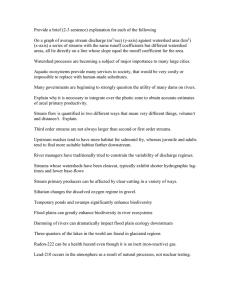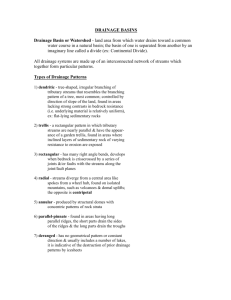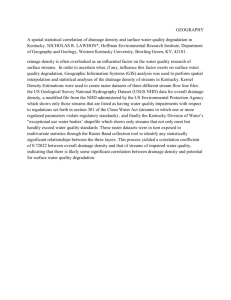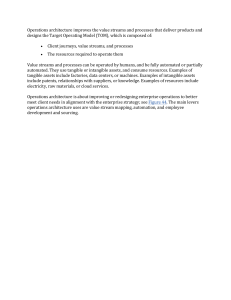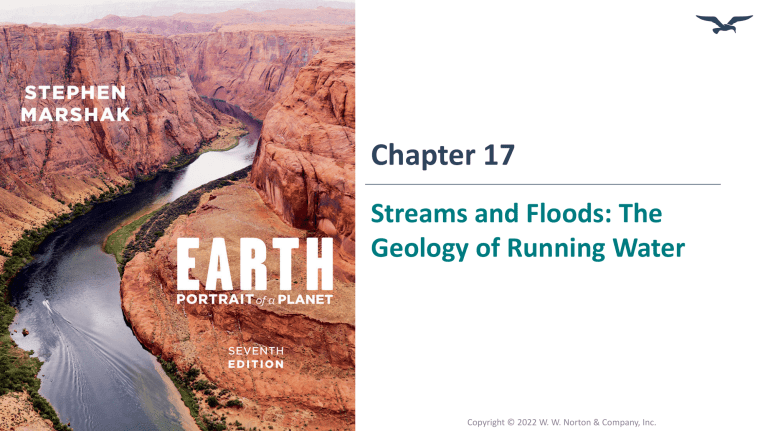
Chapter 17 Streams and Floods: The Geology of Running Water Copyright © 2022 W. W. Norton & Company, Inc. Review – Mass Wasting § We can distinguish between different types of mass wasting based on several factors: 1) Composition and character of the moving materials. 2) Rate of movement. 3) Environment where the movement occurs. Slowest to fastest Review – Mass Wasting 1) 2) 3) 4) 5) Creep and Solifluction Rock Glaciers Slumps Mudflows Debris Flows 6) 7) 8) 9) Lahars Avalanches Rockfalls Rockslides Submarine Mass Wasting Slowest to fastest Review – Mass Wasting Why Mass Wasting Occurs § Weakened substrate § Development of relief (slope) § Triggering Event (gravity >>>> resisting force) How Can We Protect Against Mass Wasting § Identifying regions at risk • Landslide potential mapping • Surveying for surface indicators § Mitigation Chapter 17 Streams and Floods: The Geology of Running Water Copyright © 2022 W. W. Norton & Company, Inc. Streams and Floods Chapter Learning Objectives: 1) Explain how streams and drainage networks form and evolve. • • • • Erosion and deposition by streams. Characterize the changes that take place along the length of a stream from its headwaters to its mouth. Describe the evolution of meanders in a stream. Explain the concept of a floodplain. 2) Distinguish between different types of floods and the conditions that lead to each. • Describe the various engineering methods used to protect areas from flooding. 3) Characterize environmental issues associated with streams. Streams and Floods – Anatomy of a Stream § Stream: body of running water that flows in a channel (an elongate depression or trough). § Large streams = Rivers § Medium streams = Creeks A’ A Stream in Colorado https://education.nationalgeographic.org/resource/stream/ Streams and Floods – Anatomy of a Stream § Stream: body of running water that flows in a channel (an elongate depression or trough). § Banks = Channel Edges § Streambed/Bed = Bottom of Channel Cross Section of a Stream A A’ https://geo.libretexts.org/Bookshelves/Geography_%28Physical%29/The_Environment_of_the_Earth%27s_Surface_%28Southard%29/05%3A_Rivers/5.05%3A_The_Morphology_of_Rivers Streams and Floods – Anatomy of a Stream § Water in streams flows its source (Headwaters) to its mouth. § Downstream = direction from Headwaters to Mouth. High to low elevation. § Upstream = direction from Mouth to Headwaters. (Salmon like this direction!) https://gotbooks.miracosta.edu/geology/images/stream_profile.jpg Streams Are Important Geologic Agents § Streams drain water from the landscape and carry it into lakes or to the sea. § Important part of the hydrologic cycle! § How do streams form? How Do Streams Form? (1) § The water in streams can come from any of the reservoirs in the hydrosphere. • Precipitation • Glacier melt • Groundwater springs § Some water can be temporarily stored relatively non-flowing accumulations in lakes and wetlands. How Do Streams Form? (2) § Streams form through Erosion. § Sheetwash: A film of water less than a few mm thick on the ground surface. § Sheetwash will flow towards depressions and slowly erode them as it flows creating rills (very small shallow streams). § As more water flows towards the depression, erosion increases and the channel deepens, and downcuts. § Can also initiate at the mouth of a spring (where groundwater meets the surface). How Do Streams Form? (2) § Erosion efficiency depends on: • Velocity • Resistance of substrate to erosion How Do Streams Form? (3) § Headwater erosion: lengthening the stream through erosion at the head of the channel. § Headwater erosion occurs when water flow at the head of a channel has sufficient erosive power. Streams to Drainage Networks § As erosion deepens the main stream channel, the surrounding land surfaces start to slope towards it. § As a result, smaller tributaries form following the sloped topography to join the larger trunk stream. § The array of linked channels forms a drainage network. Drainage Networks § Drainage networks are formed when numerous smaller streams flow into one large stream. § The land drained by the network of streams is a Watershed. Drainage Networks § Drainage networks provide conduits for the removal of runoff. § Runoff: The water the flows on the surface of the Earth to drain the land • Streamflow & Sheetflow. Drainage Networks § Different drainage networks will have different configurations/ patterns of tributaries and trunk streams. The pattern that develops depends on: 1) Landscape 2) Substrate Drainage Networks Configurations 1) Dendritic 2) Radial 3) Rectangular 4) Trellis 5) Parallel Drainage Networks: Dendritic § Dendritic = branching (branches connecting to a trunk). § Forms when rivers flow over a relatively uniform substrate with a gentle slope. Drainage Networks: Radial § Radial = flow outward from the mountain peak, like spokes on a wheel. § Develops from a point uplift (a mesa, volcano, etc.) Drainage Networks: Rectangular § Channels form along the pre-existing fractures, and streams join one another at right angles, creating a rectangular network. Drainage Networks: Trellis § Trellis drainage develops in deformed strata with alternating resistant and weak rocks. § Only main channel is strong enough to erode resistant strata. Smaller tributaries restricted to weaker rocks. Drainage Networks: Parallel § Several streams form parallel to each other on the sides of steep escarpments of weak substrate. § If the surface of the substrate hosts no vegetation and many channels form, the resulting landscape can be called badlands topography. Drainage Networks § Drainage networks are formed when numerous smaller streams flow into one large stream. § Many different patterns. § The land drained by the network of streams is a Watershed. How are watersheds defined? Watersheds and Divides § Watersheds are separated by drainage divides. § Drainage Basins = term often used interchangeably with watershed. § Drainage Divide: relatively high ridge that separates watersheds. • Defined on a variety of different scales (local, regional, continental). Drainage Divides – Examples § Drainage divides and watersheds are defined on a variety of scales. § Tiny tributaries—tiny watersheds § Large continental rivers have large watersheds. § A continental divide separates flow to different oceans. • North American Corderilla Watersheds in Detail Watershed: an area of land with a topographic divide that collects rain & snow, and discharges most of this water to stream, river or other water body • Synonymous with catchment & drainage basin • Total area that drains to a common outlet Outlet (lowest point) topographic divide or watershed boundary Watersheds in Detail Ontario Watershed Mapping: https://www.lioapplications.lrc.gov.on.ca/SourceWaterProtection/index.html?viewer=SourceWaterProtection.SWPViewer&locale=en-CA Watersheds in Detail • High points divide which way water will flow • Anything within those points drain to a common outlet The Amazon Watershed § The Amazon watershed is one of the largest in the world. Precipitation falling in the highlighted region makes its way through tributaries to the Amazon. Stream Types – Volume & Flow § Streams can be classified in many different ways. As we often rely on streams for water resources it is helpful to describe them based on water volume, and duration of flow. § Water Volume • Gaining Stream = Volume of water increases in the downstream direction • Losing Stream = Volume of water decreases in the downstream direction Stream Types – Volume & Flow § Streams can be classified in many different ways. As we often rely on streams for water resources it is helpful to describe them based on water volume, and duration of flow. § Duration of Flow • Permanent streams • Ephemeral streams – All ephemeral streams are losing streams, but not all losing streams are ephemeral! Permanent Streams § Permanent streams are defined by water flowing all year. These streams are common where there is abundant rainfall, groundwater discharge, and low rates of evaporation (tropical and temperate climates). Permanent stream in Wyoming. Ephemeral Streams § Ephemeral streams do not flow all year. They are common in places with low annual rainfall, and high rates of evaporation (arid environments). The Importance of the Water Table § The location of the water table is a major determining factor on whether a stream is permanent or ephemeral. § Water Table: Boundary that separates substrate in which pores between particles are filled with groundwater, and where pores from substrate are filled with air. Arid Environment = low water table Low Rainfall High Evaporation Pores filled with air Pores filled with water Temperate Environment = high water table High Rainfall Low Evaporation Pores filled with air Pores filled with water The Importance of the Water Table Arid Environment = low water table Temperate Environment = high water table Water table is below stream bed = no groundwater can “feed” the stream Water table is above stream bed = groundwater can “feed” the stream Stream bed elevation
